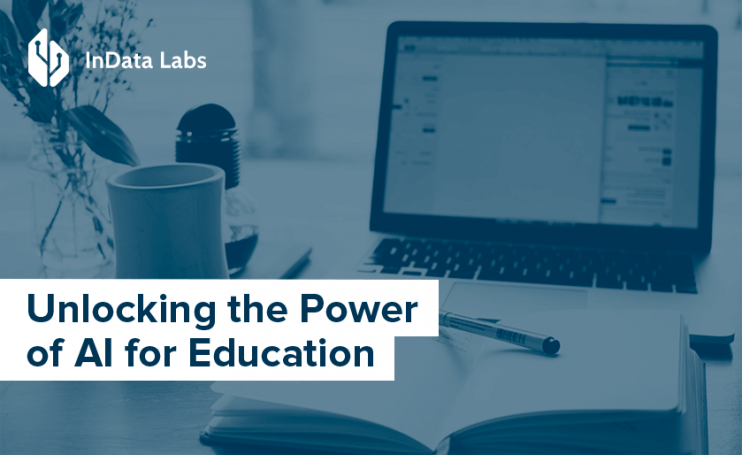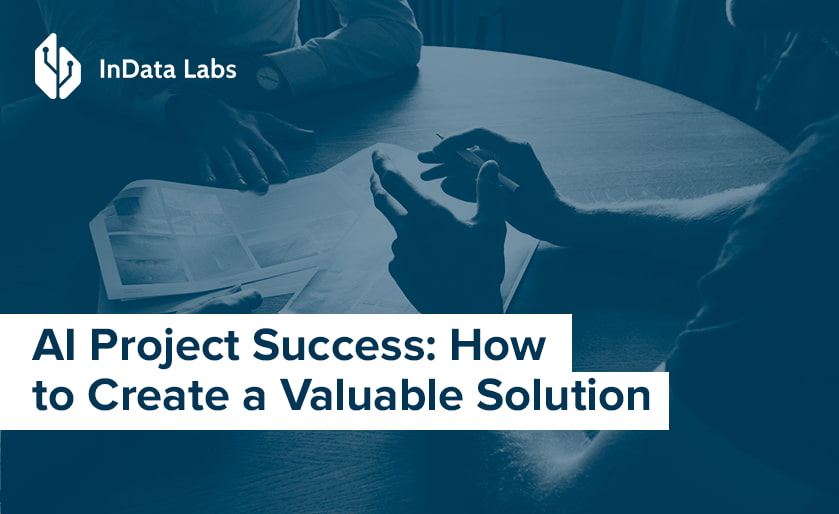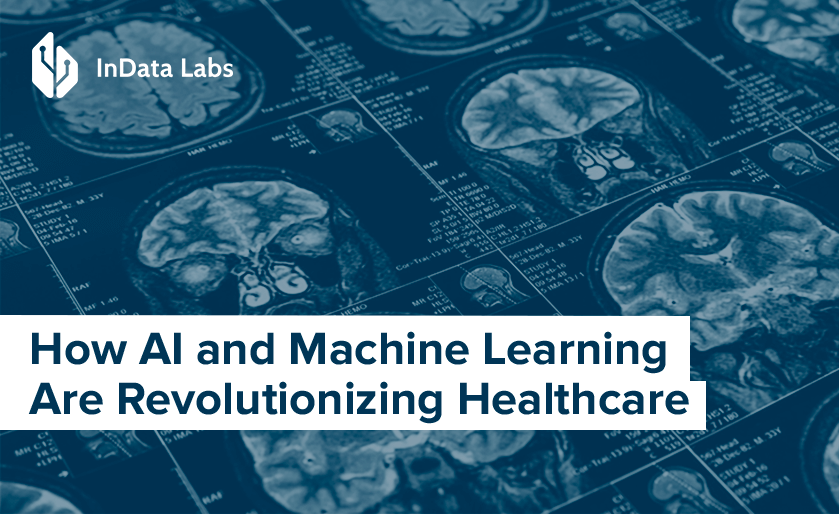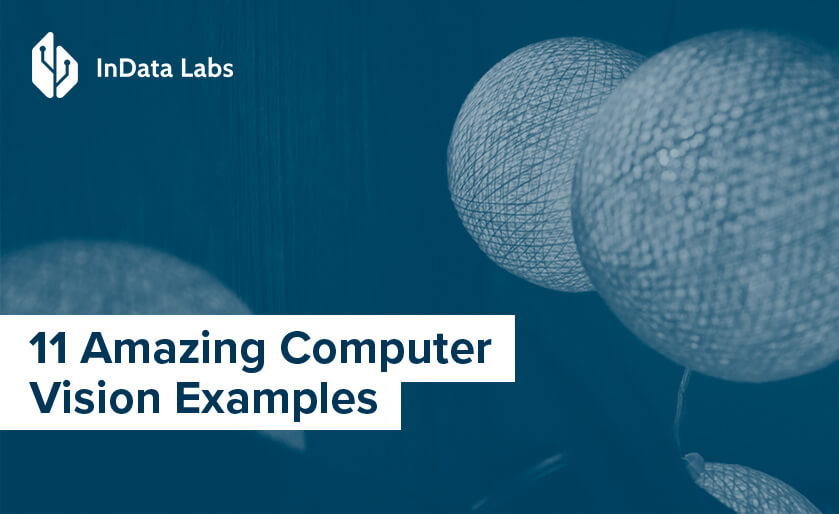Technology has been transforming most aspects of modern life at breakneck speed. It has touched upon almost everything – from banking, retail, healthcare, and sports to farming and forestry. Only one industry has remained deeply steeped in tradition: education.
Even today, in 2020, the schools in most countries are pretty similar to those we had 50 years ago. Students attend classes together and do the same tasks no matter their skills and learning abilities. As a result, some students fall behind, others can’t get ahead. Artificial intelligence could change that.
How is Artificial Intelligence Used in Education?
The good news is that slowly but surely AI enters the education sector. And it has already made its way into K–12 schools in the US. Today, AI offers aid to K–12 teachers and administrators, soothing the pain of daily tasks.
For those who are planning to implement AI into education projects in 2020 or just curious to know what impact AI has on education, take a closer look:

AI-Enabled Personalized Learning
Artificial intelligence and Machine Learning can take education to a whole new level using personalized learning. The main goal of personalized learning is to adjust the content and pace of learning to the student’s specific needs. And that’s where AI technology comes to the rescue. AI can capture and analyze large volumes of data to create a detailed student learning profile. Over the course of years, a student hands out a lot of assignments, takes tests, participates in the classroom activities, and so on. Without technology, it all usually goes in vain. But with AI it’s different because it never forgets a thing. It can pull together all the data related to the student and suggest a teacher how to better personalize the materials for the student.
The benefits of artificial intelligence in education are obvious. It has already gained momentum in K–12 and is entering other stages. It’s safe to say that it has the potential to disrupt higher education. AI can become a powerful tool to remove the traditional “one-size-fits-all’ approach to education because it’s no longer working. With hyper-personalization in place, every student will get a unique educational approach curated to their specific needs and learning abilities. Providing personalized content at the right pace, artificial intelligence technology makes the student the center of the education process.
AI in Online Education
As on-campus education gets more expensive, students around the world are opting for cheaper alternatives to replace it. ‘Incoherent, old-fashioned and rather costly’, that’s how most modern students describe the traditional educational system we have today. They seek novel learning methods, learner-centered and personalized content, and a promise to have an in-demand job after graduation. AI might not ease the future job search pain but at least it can deliver the right type of content tailored to the specific needs of a student.
AI is not the future, it is present. Step by step, it’s revolutionizing education. Today, AI in online education means the rise of affordable options. Take online schools and universities. They work to make education affordable for everyone. They use innovation to get a glimpse of the job market and create in-demand programs. This is the type of education we should look up to.

Source: Shutterstock
What concerns the post-pandemic predictions, experts claim that Blended Learning will increase significantly. We don’t know what the future holds but can assume that some universities and colleges, affected by the pandemic, will have to close down or make a fast shift to online education. To make this shift easy and smooth, educators can count on remote learning platforms and various education applications powered by artificial intelligence. They’re good enough to showcase the content online, organize remote debates as well as make and submit assignments.
Some experts claim that the Covid-19 will change education in the long run. The way people learn will no longer be the same. Remote education will no longer be considered as an option. It’ll become the cornerstone of education. And artificial intelligence can ease the transitioning to that.
Automation in the Classroom
Artificial intelligence fuels education processes like evaluation and grading. These processes are daunting and oftentimes eat up a lot of time. Artificial intelligence education technology might not be close to flawless grading, but it’s enough to reduce the educators’ load. Passing the task of grading to AI, teachers can devote more time to students.
And there are more advantages of AI in education to come in 2020. Take automated scheduling and planning. The technology offers a robust solution for the problem of manual timetable preparation. Providing educators with optimum and conflict-free class schedules or delivering content on time, AI frees up their heavy workloads.
VR and AR Learning
Virtual Reality (VR) is revolutionizing education. It has a lot to offer, from visiting the volcanoes, discovering marine animals to studying human anatomy in a science-based yet engaging way. VR technology is designed to capture the students’ attention and improve learning retention significantly. It enables interactive and engaging learning for students of all ages. Let’s dive into some examples.
Take K – 12 schools, where VR is being used on a large scale. It’s proved successful in improving writing and speaking skills of the students who have had a chance to plunge into an immersive world. It is safe to say that the immersiveness and liveliness of VR help nurture language development in the early years.

Source: Shutterstock
Apart from advancing conversational skills, it’s widely used to help kids with ASD (Autism Spectrum Disorder). Most of the autistic kids can’t stand loud noises and oftentimes distance themselves from teachers and peers. And that’s where VR technology comes to the aid. It enables a real-time immersion into a virtual world where a kid can safely explore various concepts and gain the necessary skills. The US Department of Education relies on AI to revolutionize education through technology. Specifically, it’s been taking the initiative to employ VR to help children with autism develop social skills. Using the VR headset, the student will take a virtual tour around the school with computer-powered avatars. The main objective of the project is to teach children about positive and negative interactions in a less aggressive environment and help them pick social cues at a faster pace.
Another example of AI in education can be Augmented Reality (AR). According to the Common Sense Census, 53 % of children have a smartphone by the age of 11. And 84 % of them not only play games or watch YouTube but engage in rather complex experiences. And it literally means that they are ready to welcome and other computer vision solutions in the classroom. Augmented reality has the potential to brighten up boring classes and engage students better. Diving into an interactive and lively learning process, students study a large amount of information and also improve teamwork skills.
Real-time Attendance Systems with Face Recognition
Face recognition, a subset of AI, is slowly paving its way into the education sector. Face recognition technology offers an innovative way to track student attendance.
Today, there’s plenty of face recognition apps that relieve the burden of manual student attendance procedure. Such apps are designed to identify a student’s face and register their attendance. They check students against the database and inform the educator who’s present and who’s playing truant. Another benefit is that the system can generate multiple reports to keep in the loop both educators and the faculty. Thanks to face recognition technology, there’s no need to call upon student names during the morning attendance roll or make attendance reports manually. Face recognition has covered it all.
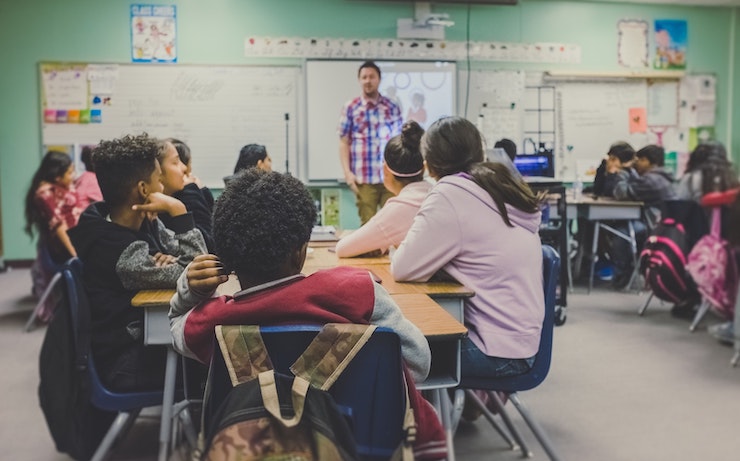
Source: Unsplash
NLP and its Benefits in the Classroom
NLP is a field of machine learning that is used to analyze sentiment in real-time and draw valuable insights based on this data. Recently, NLP has become a new artificial intelligence trend in education. Natural language processing tools and techniques have proved to be effective in “looking beneath the surface” – understanding emotions and defining what the sentiment of the message was about.
Emotion detection systems based on natural language processing algorithms help identify emotions like confusion, joy, anger, discomfort, happiness, and so on. They help teachers decipher the meaning the student tried to imply. Overall, NLP helps streamline the grading process making it efficient, fair, and thorough.
Another prediction for future education is linked to the NLP-based internal maps of the world. The main concept of these maps is to test out as many learning methods as possible and then accommodate them into the leaning process. Incorporating anchoring, state elicitation, and flexibility of response into the classroom, both educators and students benefit from it. Utilizing natural language processing techniques in the classroom, the learning process becomes more perceived, engaging, and yet effective.
AI Investment in Education by Countries
China has always been heavily investing in education. Believing the statistics, last year the country spent $1 billion on AI education. Every now and then new EdTech startups emerge in China. For example, Squirrel AI aiming to bring personalization and individual support to students from K – 12 to higher ed. The project is thriving – the company has already opened about 2,000 centers in 200 Chinese cities and isn’t planning to stop.
Another striking example is Alo7 targeted at young English learners. The project includes engaging games and interactive videos aimed to nurture a kid’s talent and encourage their imagination.
The USA comes second after China in the AI education investment race. The country spends a lot on AI annually and has a lot of AI firms within the country. Leveraging AI into the US education system, they opt for individualized learning with a focus on student’s needs. The idea behind that is to deliver content, identify learning gaps, and aid the student with learning methods that fit them best.
What are the Disadvantages of Artificial Intelligence in Education
No doubt, AI-powered education is here to stay. But what are the pitfalls? Mostly, it’s bias.
AI algorithms are smart enough to grade essays but fool to analyze the meaning of the message.
Back to August 2019, a Motherboard started an investigation on e-grading systems scoring essays submitted by African-American and Chinese students differently:
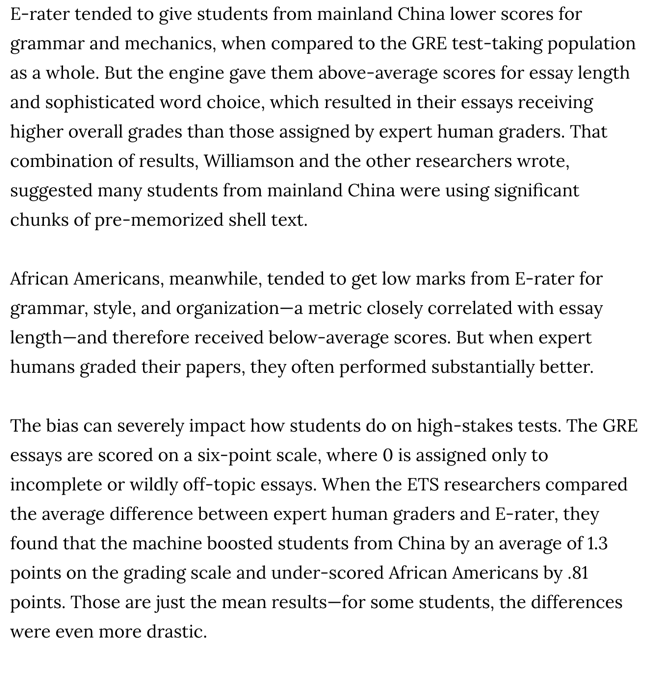
Source: Vise.com
Sometimes, e-scoring systems might do more harm than good. The bias comes from biased humans.
The best way to beat up bias is not to be biased ourselves. And what concerns the grading process, experts advise sending essays to human for a final grade to be made.
Other drawbacks AI has:
- cannot fully replace teachers, because doesn’t teach important social skills
- requires access to the Internet, thus its implementation can be a problem for countries with slow connectivity
- costs of development and implementation
Final Words
From K – 12 to adult education, artificial intelligence has something to offer to every grade. It is altering the academic world making education interactive, effective, and affordable for everyone. The benefits of AI in the classroom are evident. It makes remote learning real, frees up the workload of educators, and engages students better. However, AI is not even close to substituting teachers. That’s why it should be considered a digital assistant in the classroom, not an educator.
Let’s Work on Your Breakthrough AI Software Development Project Together
Schedule an intro call with our AI company to explore your business and find out how we can help.
